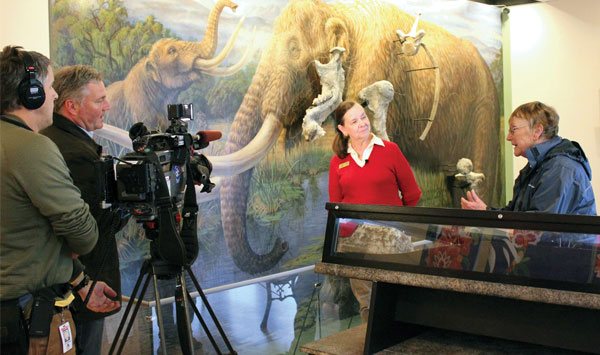by MARK ST.J. COUHIG
Sequim Gazette
An event that occurred in Sequim more than 30 years ago is now making headlines around the world.
In the summer of 1977 Sequim resident Emanuel “Manny” Manis was using a backhoe to dig a pond on his property when he turned up the skeletal remains of a mastodon. While it immediately was recognized as a significant find, until this week few knew exactly how important the skeleton is in writing the history of mankind.
A new study of the Manis mastodon provides proof of the oldest human settlement found to date in the Americas.
The site is significant for more than being the oldest: For decades, most anthropologists studying early Americans believed the very earliest settlement was found in present-day Clovis, N.M. “Clovis man” was considered more than just the creator of a few tools and weapons; he was said to be a kind of cultural father to all ensuing generations of Native Americans.
A new article released this week in the well-respected scientific journal “Science” overturns that theory, providing proof that Happy Valley, near present-day Sequim, was populated by hunters 800-1,000 years before Clovis.
Clare Manis Hatler, widow of Emanuel Manis, says the new work is particularly welcome because it validates the work of Dr. Carl Gustafson, the retired Washington State University archaeologist who originally excavated the site and whose conclusions have long been cast in doubt.
Professor Eske Willerslev’s team from the Centre for GeoGenetics, University of Copenhagen, produced the study in collaboration with Michael Waters’ team at the Center for the Study of the First Americans, Texas A&M University. It shows that the hunt for large mammals occurred at least 800-1,000 years before previously assumed. This new study concludes that the first-known hunters in North America now can be dated back at least 13,800 years.
“The ‘Clovis First’ theory, which many scientists swore to just a few years back, has finally been buried with the conclusions of this study,” said Willerslev.
Tools and artifacts found in Clovis in the 1930s were carbon dated at 13,000 years old.
A little pre-history
Waters said the distribution of the bones and the discovery that some of the bones were broken suggested that the mastodon had been killed and butchered by human hunters.
However, he explained, no stone tools or weapons were found at the site. The key artifact from the site was what appeared to be a bone point sticking out of one of the ribs, but the artifact and the age of the site were disputed.
Three years ago Waters contacted Gustafson, the original excavator, about performing new tests on the rib with the bone point. New radiocarbon dating confirms the site is 13,800 years old. High resolution CT scanning and three-dimensional modeling also confirm that the embedded bone is a spear point and DNA bone protein analysis shows the point was made of mastodon bone.
“The Manis site is an early kill site,” Waters concluded.
The mastodon remains in Sequim, partially reconstructed as part of a large exhibit at the Museum & Arts Center at 175 W. Cedar St. Renee Mizar, MAC communications coordinator and executive assistant, commented on the new findings, saying, “We have known for years that the Manis mastodon was a significant archaeological discovery and this latest scientific research reinforces that all the more. With regard to the Museum & Arts Center, the Manis mastodon has been a cornerstone exhibit at our Exhibit Center for many years, and while this study does not change the core of the exhibit, we are actively exploring various ways to update it accordingly. Our long-term plan in updating the exhibit includes properly re-exhibiting the mastodon tusks and we welcome donations toward that project.”
Vindicating the work
Hatler said the recent research provides “vindication” for Gustafson. When Gustafson researched the find in the late 1970s, “They didn’t have all the CT scans and the DNA,” Hatler said, so Gustafson had to rely on more primitive techniques.
Gustafson found the projectile point and noted the wound showed signs of healing, indicating it was buried in the bone while the animal was still alive.
Gustafson declared the projectile was man-made, but that remained a matter of debate until this week.
Gustafson sent pieces of the skeleton to labs around the country for radiocarbon dating, which confirmed it was 13,800 years old. Unfortunately, he couldn’t similarly test the all-important projectile. The more primitive methods of the time would have “destroyed” it, Hatler said.
“He was challenged — as science always is — especially by the Clovis people,” Manis said. Clovis points are stone, she said. “Back then if you didn’t find a Clovis point, then you didn’t have a kill site.”
“He was kind of beat up about it,” Hatler said.
Hatler said three years ago Gustafson was approached by Waters, who promised he would “take that rib bone and give it all the tests that modern man knows about. The last three years it’s been tested by the top scientists,” she said. “It’s way beyond what they had in the ’70s.”
“And they found out Gustafson was right.”
Gustafson’s further finding — that the bone weapon was from another mastodon — also has been confirmed through DNA testing.
Gustafson conducted additional research at the site, finding more bones and bone tools. In fact, he brought up evidence of continual human habitation of the area until 8,000 years ago.
Gustafson may release his additional data. “He found other bison that were butchered and another mastodon,” Hatler said.
The latest findings are “a vindication of his work,” Hatler said.
“That’s what counts.”
“But we always knew it was so.”
The Manis family long ago put the two-acre site in Happy Valley under the control of the Archaeological Conservancy, an Albuquerque, N.M., nonprofit dedicated to preserving significant archaeological sites.
Hatler said it will remain undisturbed unless and until members of that organization decide to conduct more research on the area.
Reach Mark Couhig at mcouhig@sequimgazette.com.



